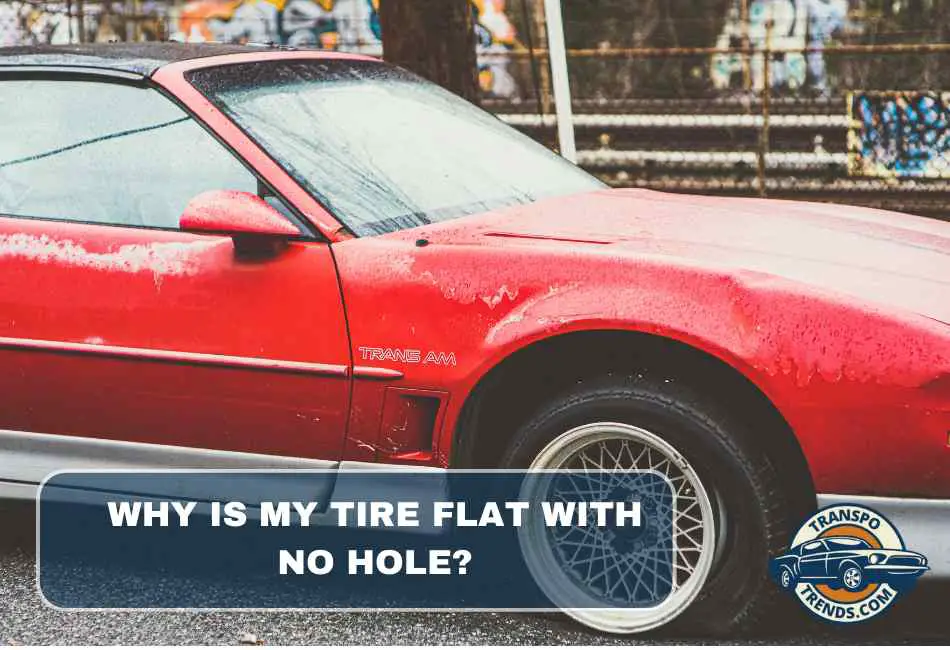Have you ever experienced a perplexing situation where your car tire continuously goes flat with no evident puncture?
I have, and it was a frustrating riddle that drove me to delve deeper into the intricate world of automotive troubleshooting.
Most drivers, including myself at one point, associate a flat tire with a visible hole or puncture, often resulting from a sharp object like a nail or a shard of glass.
However, there are scenarios where your tire can lose air without a discernable hole, which may leave you scratching your head.
Many hold common misconceptions, such as assuming the presence of a hole is the only reason for a tire to go flat.
This article aims to debunk those misconceptions and explain the precise reasons why a tire can lose air, even without an obvious puncture.
Understanding Tire Basics
Before we dive into the causes of mystifying tire deflations, it’s important to grasp some tire basics.
Understanding a car tire’s basic structure and components can go a long way in helping diagnose and resolve tire issues.
Tire Composition and Structure
First, let’s talk about what a tire is made of. Believe it or not, there was a time when I thought a tire was just one solid piece of rubber, but boy, was I wrong.
Car tires are composed of several layers, including the tread, sidewall, beads, and interior structure, all made from natural and synthetic rubber.
The tread is the part of the tire that makes contact with the road, while the sidewalls provide stability.
The beads hold the tire onto the wheel, and the interior contains the inflation chamber.
Importance of Airtight Sealing for Maintaining Tire Pressure
If you remember the day you got your first car as vividly as I do, you might recall your parents or the dealership emphasizing the importance of maintaining proper tire pressure.
The tire needs to be completely airtight to hold the air inside. Any disruption, even microscopic, in this airtight seal, can cause the tire to lose air slowly.
This doesn’t always result from a visible hole or puncture. Sometimes, it can be due to a compromised bead seal, a damaged rim, or even a worn-out tire valve.
The Role of the Valve Stem in Tire Inflation
Speaking of tire valves, I learned their importance the hard way. I once spent an entire afternoon trying to inflate a tire, not realizing the valve stem was damaged.
The valve stem is a small, often overlooked tire component vital in maintaining tire pressure.
It allows air to be pumped into the tire and prevents it from escaping. If the valve stem is damaged or faulty, air can slowly leak out, causing a gradual tire deflation without a visible hole in sight.
Can a Tire Go Flat Without a Hole?
A tire can go flat without a hole! I know it sounds counter-intuitive. After all, we expect air to escape only when there’s an opening.
But tires are more technically sensitive than we imagine. They are not just simple rubber constructions that hold air inside; they are complex pieces of engineering.
A tire is a robust yet sensitive system that maintains a delicate balance. A minor fault in any of its components can disrupt this balance, leading to slow air loss and eventual deflation.
I learned this the hard way when my tire went flat without visible puncture. Let me explain how a tire can go flat without a hole.
1. Faulty Valve Stem
The valve stem is crucial for maintaining tire pressure. It’s the small protrusion to which you attach the air pump when inflating the tire. Without a functioning valve stem, your tire will gradually lose air.
Valve stem issues are often caused by simple wear and tear or damage from road debris. I remember finding my tire flat and seeing the valve stem had been sheared clean off!
The solution to a faulty valve stem is replacing the valve stem assembly. I had to drive to a nearby auto repair shop for a quick and relatively inexpensive fix.
2. General Tire Damage
General tire damage can occur without any visible puncture. These damages include minor cuts or abrasions to the tire’s rubber or sidewall bulges.
A consistent drop in tire pressure is the most obvious sign of tire damage. On one occasion, I noticed my tire looked lower than usual, even after regular inflation. That was my cue to get it checked.
The solution to general tire damage is replacing the tire and its pair, ensuring an even wear and maintaining balance while driving.
3. The Wheel Is Damaged
The metal wheel is an integral part of tire sealing. If it gets damaged, it can disrupt the tire’s seal, causing air to leak.
Common causes of wheel damage include driving over potholes or curbs. You wouldn’t believe it, but a simple drive-through at a fast-food joint once lead to a bent wheel for me!
The solution to a damaged wheel is to purchase a new wheel and reseat the tire onto it.
4. Changing Temperatures
Changing temperatures have a significant impact on tire pressure. Colder temperatures cause the air inside the tire to contract, lowering the tire pressure.
Recognizing seasonal vs. persistent issues is vital. I noticed my tires deflated faster during winter, but the problem persisted as spring approached.
The solution is monitoring your tire pressure regularly and making seasonal adjustments to tire inflation as needed.
5. Dry Rotting Tires
Dry rot in tires is caused by the degradation of natural rubber over time. Signs of dry rot include cracks or brittle areas on the tire surface.
Prevention measures include regular tire maintenance and avoiding long periods of tire inactivity. My old car in the driveway for a year had tires that fell victim to dry rot.
The solution to dry rotting tires is immediate tire replacement.
6. The Tires Came Unseated
Incorrect tire seating can cause the tire to unseat or detach from the wheel’s rim.
Instances of unseating can occur after a hard impact or if the tire was improperly installed. This happened to me once after an off-road trip.
The solution is to have the tire replaced and reseated correctly by a professional to ensure optimal performance and safety.
Conclusion
In summary, there are several reasons why a tire can lose air without having a puncture. These include valve stem leaks, wheel damage, changing temperatures, dry rot, and the tire coming unseated from the rim.
As I’ve learned from experience, each issue can lead to unexpected deflation and flat tires, turning a simple drive into an unexpected pit stop.
I cannot stress enough how crucial it is to promptly identify and address these issues. Each has signs and solutions, and taking action early can prevent minor problems from escalating into major ones.
Believe me when I say it is far better to replace a damaged wheel or monitor pressure changes seasonally than to be stranded on the highway with a flat tire.
Finally, don’t guess when it comes to tire health. If you are experiencing persistent tire deflation or other tire-related issues, I highly recommend you consult a professional.
Tire providers and automotive professionals can properly diagnose and fix the problem, saving both time and money in the long run.
I once tried to fix a valve stem leak on my own, and let’s just say it was an experiment I won’t be repeating!

